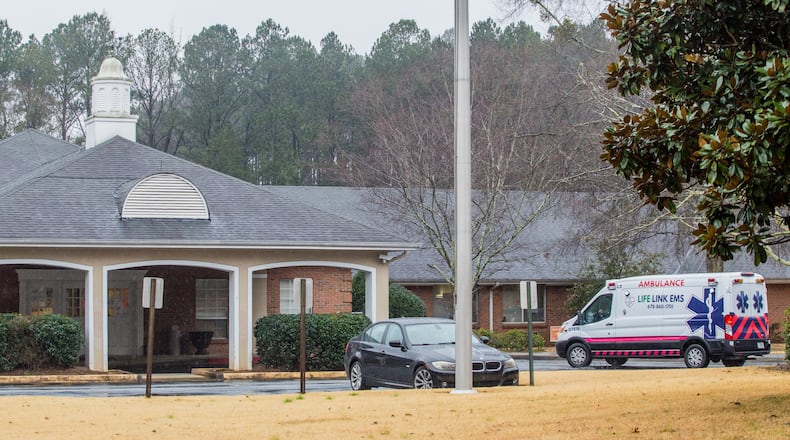The Rosemont at Stone Mountain had 22 COVID-positive residents in October when inspectors discovered a lapse at the nursing home: It did not have a qualified infection prevention expert on staff. A month later, dozens more tested positive, state reports show.
Yet days before Christmas, an inspector found some workers at Rosemont weren’t wearing masks and face shields as required. The home had other troubles in December, too. An inspector saw roaches in multiple rooms and was told pest control was on hold until the home paid its bill. One resident told the inspector the rooms always have roaches, so he only alerts staff “when the roaches crawl in the bed with him.”
Then on one day in January, Rosemont reported 21 COVID-19 deaths to the state’s daily public case-tracker. That number, its executive director said, covered the entire pandemic. She declined to elaborate.
Erratic reporting by long-term care facilities accounts for part of a startling spike in deaths reported in Georgia long-term care facilities last month. But the numbers primarily reflect a disturbing surge that came after the holidays, underscoring dangerous conditions that have persisted since the pandemic began.
Credit: Jenni Girtman
Credit: Jenni Girtman
Long-term care homes reported more than 700 COVID-19 deaths in January, the highest one-month total. The number of residents reported as testing positive last month set records, too.
Losses mounted even as most residents of long-term care facilities haven’t been able to have visitors for months, under emergency orders issued by Gov. Brian Kemp aimed at stopping outbreaks.
Workers come and go, though, and often bring the virus with them, especially when COVID-19 is widespread in the community. Given the likelihood that cases in communities would rise as people gathered over the holidays, “you would think facilities would be extra, extra cautious,” said Melanie McNeil, Georgia’s long-term care ombudsman.
However, inspectors in recent months have found lapses in infection control at homes across the state, including not screening staff for symptoms of COVID-19 and not separating residents with COVID-19 from those without the virus. Inspectors also cited homes for other violations, including neglect, that could leave residents more vulnerable.
Credit: Jenni Girtman
Credit: Jenni Girtman
How many residents suffered the ultimate price for the failure to follow protocols can’t be known. It’s been challenging from the start for the public to track cases inside Georgia’s homes. Some don’t report their statistics to a public site, and state and federal numbers can vary for the same facility. Worried family members with loved ones at some long-term care homes say they have had difficulty getting information during an outbreak, even though nursing homes are required to notify them of COVID-19 cases.
“The lack of reporting of deaths leaves families in the dark and leaves the community in the dark,” McNeil said.
Problems widespread
Long-term care residents across the state were in the first group — along with health care workers — to get access to vaccines. By the end of January, most had gotten at least a first dose, if they wanted it.
With the vaccine’s arrival, many hoped the worst was over. But it was too late for some. While the state’s tracker showed about 3,300 deaths at the start of the year, the total now tops 4,100, about 30% of the state’s confirmed total.
“Just as January was a record-setting highest point for the state of Georgia, it was true for our centers as well,” said Tony Marshall, president and CEO of the Georgia Health Care Association, which represents nursing homes and assisted livings across the state.
“It was a very emotional and very difficult time for our centers to see such a significant spike in some centers that had not seen cases in months,” Marshall said.
State reports show that 15 Georgia facilities reported 10 or more deaths in January alone, the AJC found.
“The lack of reporting of deaths leaves families in the dark and leaves the community in the dark."
In Columbus, Britt Hayes was among those who witnessed a sharp spike as the vice president and chief operating officer of the local hospital authority, which operates two nursing homes.
Between the two facilities, 209 residents tested positive and 32 died during January, he said. That made the homes among the hardest hit in Georgia during the latest surge.
“It was very demoralizing for everyone involved because we had done so well,” he said. They had never lacked for PPE, he said, and they seemed to keep the virus from running wild earlier in the pandemic, he said. But rates rose in the community and then it spread rapidly among residents.
“I swear to you this is a different strain than what we were going through in the spring, summer and fall,” he said, based on how quickly and easily the virus spread.
More residents might have died, Hayes said, but the home arranged for monoclonal antibody infusions to be given to residents who tested positive, a treatment authorized by the FDA in November.
“It’s been an enormous task and very emotionally draining,” he said.
While the staff was stressed, inspectors discovered some shortcomings at the hospital authority’s facilities. At Orchard View, an inspector in January found the home didn’t use adequate precautions with a resident who had been exposed to a COVID-positive resident. The inspection also found some employees didn’t wear proper PPE at all times. At Muscogee Manor, an inspector in December noted incidents where workers failed to keep a mask over both their nose and mouth at all times.
Calls for change
With perilous conditions persisting in too many homes, there are growing calls for the state to better protect residents, including figuring out a way to let family members safely return, so they can be advocates and provide comfort as well.
“(T)his January report of the death toll in long-term care indicates that we must do more,” said MaryLea Boatwright Quinn, government affairs director with the Georgia Chapter of the Alzheimer’s Association.
Jennifer Austin is among those pushing for change.
Her aunt, Jean Anderson, a retired teacher, was among those who didn’t make it. She died at Orchard View, in Columbus, not long after testing positive. Anderson, who was 77, had no children, and Austin and her sister were close with their aunt and managed her care.
Yet Austin said it was difficult to get information about her aunt, and even her pastor wasn’t able to visit her. She said she thinks it’s time to ease the restrictions on visitors and she’s supporting pending legislation that would authorize visits.
“It is an incredibly sad situation with COVID and when it personally touches you, the whole pandemic takes on a whole different meaning for you,” she said.
Mona Griffin, whose 93-year-old mother was among those who got COVID-19 at Orchard View, also wants change.
“Everybody on mother’s hall died except for mother,” she said.
With the nursing home locked down, her mom, Jeanette Hicks, crocheted dozens of blankets to occupy her time while isolated from her family. Griffin stayed in touch through FaceTime and by visiting outside her window.
But when her mom was in the COVID unit at the home, Griffin described high-stress days when she had difficulty getting information, worried that her mom was not getting the right medications or the attention she needed because the staff was stretched so thin.
She was terrified her mother wouldn’t make it through. She’s still weak, Griffin said, and the isolation has taken a toll.
Griffin feels like the lockdowns banning visitors simply have to stop. She said she would wear a mask, gown, gloves, a face shield — whatever it takes — just to visit with her mother.
“I feel like I’m in battle,” Griffin said. “We all shouldn’t be in a battle. We all should be on the same vessel, working toward making their quality of life to be the best it could be, in this end of season.”
About the Author
The Latest
Featured








